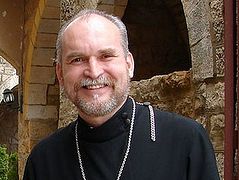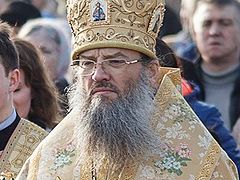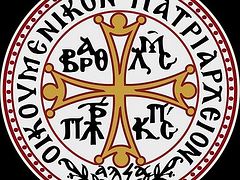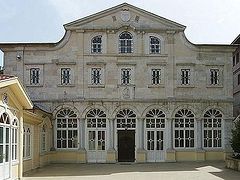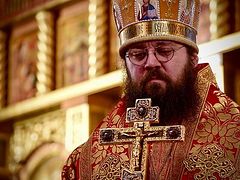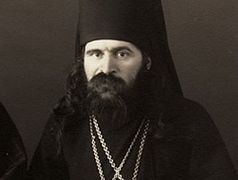The jurisdictional pretentions of the See of Constantinople have a long history. Being politically driven, they at the same time possess a strong ideological basis. Researchers have so far examined the imperial ideology of Byzantium only in the context of socio-political processes; however, recent publications and declarations from the hierarchs of Constantinople present this ideology as a very strange deviation in the form of a new teaching in Orthodox ecclesiastical hierarchy.
The danger of the emergence of a new, corrupted doctrine concerning the Church is obvious—it’s now already contributing to separation between Churches, and the main position of the new [ecclesiastical] structure of the Ecumenical Church receives theological grounding.
The latter directly leads to the emergence of doctrinal corruptions of Orthodox ecclesiology. What precipitated the rise of this problem?
A Fountain of “Bitter Water”1
The sacral2 character of Imperial authority was an indispensable component of the beliefs of Greeks at the time of the Byzantine Empire. Emperor Gratian in 375 A.D. renounced the title of Pontifex Maximus3 (high/greatest priest), but the tradition to connect the Imperial power and the sacred did not disappear. Emperors participated in all spheres of ecclesiastical life: they elected and dismissed Patriarchs, wrote religious texts, transferred bishops, were censed at the Divine services, and under Emperor Isaac II Angelos (1185–1195, 1203–1204) successively dismissed and appointed five Patriarchs in a row. From Theodore Balsamon we find the following remark:
Orthodox Emperors, without restriction, and whenever they choose can enter the Holy Altar, burn incense, make the sign of the cross with trikiri [three-branched candlestick] just like hierarchs. They offer catechism to the people, which is a privilege normally permitted only to local hierarchs … and since the reigngin emperor is the anointed of the Lord, by way of his anointing to rule the Empire, and Christ our God is a High Priest, thus the Emperor is also adorned with high priestly gifts.4
Without engaging in a struggle with the cult of the Emperor, Greek thought adapted, drawing the connection between the field of the sacred in the Church and the state. The historical and political expedience of the decisions concerning the elevation of the capital See, and changing the status of the capital city bishop became the Emperor’s “imitation” of the Bishop of Constantinople, during which the bishop accepted the “sacred” authority of governing the Church.
The power of the Emperor, its universal and sacred character, was transferred to the throne of Constantinople. In the testimony of Anastasias the Librarian (the Apocrisiarius of the Pope of Rome) of the ninth century, we find confirmation that the “Ecumenical” title of the Patriarch of Constantinople was already understood by the Greeks as a sign of his all-Byzantine authority:
When I was in Constantinople, and often criticized the Greeks for the word “Ecumenical”, and reproached them for vanity and pride, they objected, saying that they did not call the Patriarch “Ecumenical” (Oikumenikos, which can be translated as “universalis”) because he is the bishop over the entire world, but because he has the authority over one part of the world in which Christians live. That which the Greeks call the universe – oikumene – does not only mean “The World” like in Latin (orbis terrarium), [but the Greek word Oikumene] from which comes the title Ecumenical [Oikumenikos] also means “every dwelling or habitable place.”5
V. Kartashev clarifies the words of Anastasius, translating “Oikumenikos” as meaning “of the Eastern Empire”, Pan-Hellenic6, All-Byzantine.”7 This meaning of the title of the Patriarchs of Constantinople soon took on an immediate sense. During the seventh and eighth centuries, the Byzantine Empire experienced a series of upheavals, as a result of which, significant parts of its territories were seized, first by the Arabs and Persians, and then by the Turks.
As a result, the cathedrae of the three Patriarchs (of Alexandria, Antioch, and Jerusalem) found themselves outside the borders of a Christian state. Naturally, Constantinople began to be perceived not only as the capital of the state, but also as the capital of the Church, the main bishops of which (the Patriarchs) de facto dwelled in. With time, this historical fact became reflected in the works of thinkers of that epoch, and also in the normative texts.
In the Epanagoge, a collection of laws of the ninth century, we find very radical ideas concerning the Patriarch of Constantinople. Title III begins with the definition:
The Patriarch is a living and animated image (icon) of Christ, witnessing the truth in word and deed.8
In the fifth and sixth chapters of the third Title, the Patriarch is attributed special powers in the field of the interpretation and enforcement of the norms of Orthodox canons, which read respectively:
The Patriarch alone must interpret the rules of the ancient Patriarchs, and the definitions declared by the Holy Fathers, and the positions of the Holy Synods.
The actions arranged by the ancient Fathers in the Councils and in diocese, especially in councils, the Patriarch must treat, employ, and refine.9
The expressions of the Epanagoge clearly testify to the transfer of the sacred character of the power of the emperor10 to the power of the first eastern throne. Moreover, the possession of truth also “becomes” an attribute of the primate of Constantinople, which allows drawing parallels with similar trends in the Roman Church.
This new position of Constantinople as being the “Church capital” was articulated by the Patriarch of Antioch Theodore Balsamon, and the Bulgarian Archbishop Dmitri Khomatin. Balsamon’s ornate rhetorical expressions, which provided Emperors with extraordinary opportunities in the Church, are traditionally perceived by many researchers as eastern flattery, but this “flattery” is not without real meaning. A. Lebedev cites the famous words of Dmitri Khomatin:
The Emperor, who is, and thus is called, the general supreme governor of Churches, stands above the declarations of the Councils, and he constitutes the proper enforcement of these declarations. He is the very standard with regards to ecclesiastical hierarchy, the law-giver for the life and conduct of priests … in a word, with the sole exception being the conducting of Divine services, the Emperor is granted all other episcopal privileges … as the ancient Roman Emperors were ascribed: Pontifex Maximus, the current Emperors should be regarded as the same, for the sake of [their] Imperial anointing.11
With time, these honorary titles were attached to the Patriarchal authority of Constantinople.
In 1397, the Patriarch of Constantinople Anthony IV would send the Prince of Moscow, Basil II Dmitrievich, a letter demanding the restoration of the commemoration of the Byzantine Emperor during Divine Services.
In this letter, the very same rhetoric was used with regards to the attitude towards the position of the Patriarch.
The Patriarch of Constantinople Anthony IV, in his address to Vasily Dmitrievich, writes literally the following:
We are guardians of Divine laws and canons, and are obliged to thus act in relation to all Christians, especially with regards to great people—princes of nations and local lords—such as your nobleness … inasmuch as I am a universal teacher for all Christians, I have an indispensable duty: When I hear concerning your nobility, that something is hurting your soul, to write to you about it, like your father and teacher, instructing and encouraging you to correction. And you, as a Christian, and a son of the Church are obliged to correct yourself… Do you not know that the Patriarch takes the place of Christ, from which he sits on the Master's throne? It is not a human who you despise, but Christ himself! And on the contrary, he who honors the Patriarch honors the very Christ Himself!12
If these words were to be understood literally, we could call Patriarch Anthony “the Vicar of Christ.” At the same time, taking authority from the Pontifex Maximus, the Patriarch sees here a sacred instilment by Christ Himself. The mouth-piece of the universal authority of the empire, he is now becoming “the universal teacher for all Christians.” In the Russian tradition of historical science, it was customary to consider these words as simply a part of Eastern etiquette, but the subsequent development of events in the twentieth century allows us to see the immediate significance beyond these expressions.
Life after death … of the Empire
With the fall of Constantinople, much has changed. The Emperor disappeared, and in the Greek world, the only one who can bear the burden of “sacred authority” remains the hierarch of Constantinople. With strict adherence to the letter of the canons, this should not have happened, inasmuch as Constantinople ceased to be the city of the Emperor and the Senate, and ceased to exist as an ecclesiastical center, its Patriarch was now simply the Bishop of Istanbul.
Nevertheless, under Turkish rule, the Patriarch of Constantinople receives the title “millet-bashi of Rum,” and becomes the head of all Christians living on the territory of the Ottoman Empire. Millet-Bashi is a title that included secular functions, literally meaning “head of the [client] nation.”
From now on, the Sublime Port13 [Ottomans] decided on all issues relating to Eastern Orthodoxy, through the Patriarch of Constantinople, and making all aspects of the public life of the Greek-speaking population14 dependent on him, all ideas of the sacred character of power which were previously processed by the Emperor, were naturally transferred to him. This opened the way for new claims to universal power for the Patriarch, which were not formed immediately.
By 1832, after the long struggle for independence in the course of the latest Russo-Turkish War, with the positive participation of England and France as well, the Greek Kingdom was formed. This was a very significant event, since the Greek Church now had a “City of the King and Senate,” their state appeared, and according to the canons (IV Ecumenical Council, Canons:17 and 28, and the Trullan Council, Canon 38) the ecclesiastical center was to be moved to Athens. This did not happen, and in 1833, Greece declared its ecclesiastical independence. Self-declared autocephaly was confirmed by the Constantinople See, located in the center of the Islamic world—in Istanbul—in 1850.
This moment can be considered the final factor in the establishment of contemporary Constantinople, and the formation of new aspirations in its ecclesiology. According to the logic of Church canons, the Church of Christ is a universal phenomenon in and of itself, and is open to all believers in Christ, but this universality must not necessarily be connected to state borders. Changes in these borders lead to a change in the structure of the organization; we can see how this happened in the long history of the Church of Constantinople. The Church always remains in the center of the political life of the society of Orthodox Christians, regardless of the place in which it is located, or in which this center moves.
The Greeks, who for many years had their center in Istanbul, in a specific city, then absolutized it as the mythical Constantinople. The transfer of the capital from Rome to Constantinople was seen by them as quite lawful; however the transfer of the Patriarchate to Athens from Istanbul was not possible. The opportunity to normalize ecclesiastical life by transferring the center of the life of the Church from Istanbul to Athens was not fulfilled, and this in turn led to changes in the activities of the Church of Constantinople.
From this time onward, the 28th Canon of the Council of Chalcedon was perceived by Constantinople not as a conciliar rule, but as a historical fact, granting it, as the center of Orthodoxy, extraordinary powers. From then on, Constantinople has fought for control of the Diaspora—in general, all parishes located beyond its official borders—since its communities [within Turkey] are not enough. From now on, the scope of Constantinople is political, henceforth it is not the historical Mother Church but the invading Church. The role of the Church of Constantinople, which does not now possess the opportunity to have a normal Church life on its own canonical territory, is also interpreted differently.
In the Epoch of War and Revolution
With the end of the nineteenth century, a new stage in the realization of the ecclesiastical-political interests of Constantinople began. It was connected, first of all, with political regime changes within a number of states, including Russia and Turkey. After the defeat of Turkey in the First World War, the Greek independence fighters raised their heads. A nationalist rise began among the Greeks. A number of publications15 appeared on the theme of the formation of a single center of the Orthodox world, which would be headed by the Greeks, while from the other side, the “newly formed national” Churches, (including [in their opinion] the Russian), active participation and abundant funding was needed. Fr. Alexander Mazyrin writes on this subject:
There is no justification in Orthodox ecclesiology and in the canons for these plans to transform the Phanar into some eastern Vatican. They could not be met with the sympathy of the Russian Church, and only a sharp weakening [of the Russian Church] gave the Greeks a chance to implement their projects.16
Canonically speaking these plans were really unfounded, but the [new] ecclesiology in the Istanbul center of Greek Orthodoxy had already appeared, and by its logic, those perspectives seemed very solid. Greeks no longer speak about the Emperor or “The Sacred Empire,” but they have carried faith in the “New Rome” (as in the title of the Patriarch of Constantinople) through the centuries, and in the sacral character of the authority of the First Hierarch of Constantinople. The ideas concerning the sacred and universal authority of a central cathedra are pagan atavisms,17 which are strongly fueled by nationalistic aspirations. These atavisms allowed one to consider the political activities of the cathedra, if not directly sacred as before, then at least ecclesiastical in essence. For the sake of the fulfillment of “its destiny,” Constantinople considered itself able to step over all the canons and traditions of relations between Orthodox Churches.
In November of 1921, a nationalist was elected to the throne of Constantinople, the Archbishop of Athens Meletius (Metaxakis). He broke off relations with both the Greek and Turkish governments, and after the defeat of the Greeks in 1922, he found himself in a difficult situation: The Turks made it clear that they did not want to see him in Istanbul. There arose a project for the transfer of the throne of Constantinople into exile, but the Greeks stubbornly did not want to agree to this. They appealed to the international community, in particular, to the English government and the Anglican Church. At the Lausanne Peace Conference of 1922-23, Eleftherios Venizelos (a Greek politician directly related to Patriarch Meletius) said:
The Patriarch is first and foremost the “Archbishop of Constantinople, New Rome,” which, thanks to its status in the fourth and fifth centuries, was elevated to the dignity of Ecumenical Patriarchate by the decision of all Christian Churches, including the Roman Church. No one in the world can dissolve these two attributes.” “The Patriarchate cannot be transferred to another place, only a new [Ecumenical] Council can adapt a resolution on the preservation of its stay, or it’s transfer.18
It is this type of logic that was reproduced during the Synaxis on September 1- 3, 2018 by Patriarch Bartholomew:
The Ecumenical Patriarchate bears the responsibility of setting matters in ecclesiastical and canonical order because it alone has the canonical privilege … to carry out this supreme and exceptional duty… If the Ecumenical Patriarchate denies its responsibility and removes itself from the inter-Orthodox scene, then the local Churches will proceed “as sheep without a shepherd.”
At times, we confront trials and temptations precisely because some people falsely believe that they can love the Orthodox Church, but not the Ecumenical Patriarchate, forgetting that it incarnates the authentic ecclesiastical ethos of Orthodoxy.19
Speaking in defense of the Church of Constantinople, many Orthodox scholars and hierarchs, (for example, Metropolitan Antony (Khrapovitsky), Anton Kartashev) argued that any attacks on the throne of Constantinople and its primacy would lead to the collapse of the Orthodox world in general. Thus Metropolitan Anthony (Khrapovitsky), on behalf of the Temporary Holy Synod of Bishops of the Russian Orthodox Church Outside Russia (ROCOR), writes, “The abolition or the abasement of this Apostolic Cathedra would be a deep injury and blow to the entire Orthodox Church.”20 Of course, this was a political stratagem, because after all, there was never an apostolic cathedra of Constantinople.21 However, Russian rhetoric in defense of its Greek brothers was in the end not accepted as a political game but as an ideological confirmation of their quest and direction to action.
In March of 1922, the Patriarch of Constantinople Meletius issued a tomos concerning his right to:
direct supervision and management of all Orthodox parishes located outside the borders of the Local Orthodox Churches, without exception, in Europe, America, and other places”22
Starting from this time, the undisguised expansionism of the Bishop of Istanbul over the entire diaspora of the Orthodox Church begins.
This led to the rethinking of the concept of Constantinople, and concerning the Church itself. And we are now witnessing very dangerous trends by the Greek Church in the theological world.
Primus “in sheep’s clothing”
On December 25, 2013, the Holy Synod of the Russian Orthodox Church adopted a new document, “The Position of the Moscow Patriarchate on the problem of primacy in the Universal Church”.23
In response to the position of the Russian Church, a professor at the University of Thessaloniki, the Metropolitan of Bursa Elpidophoros Lambriniadis, published an article: “Primus sine paribus,” literally meaning, “The First Without Equals”.2425 This article attempts to theologically substantiate Istanbul’s jurisdictional claims. It is important to note that this article has long been located on the official website of the Patriarchate of Constantinople. Unto this very moment, the Phanar has never expressed a word of criticism against the provisions of the article, which directly speaks to the support of similar ideas by the hierarchs of Constantinople.
What is Metropolitan Elpidophoros’s argument?
First of all, the Metropolitan of Bursa reproaches the Russian Church for refusing to identify “the primacy of the Lord” and “the primacy of the bishops.” He writes:
Thus the text of the Moscow Patriarchate is forced to adopt the unprecedented distinction between, on the one hand, the 'primary' primacy of the Lord and, on the other hand, the 'secondary' primacies of bishops ("various forms of primacy ... are secondary"), although later in the same document it will be suggested that the bishop is the image of Christ (cf. 2:1), which seems to imply that the two primacies are univocal or at least analogous and not merely equivocal.26
The identification of the primacy of the Lord, and the primacy of earthly, albeit ecclesiastical authority has so far only been found in the teachings of the Roman Catholic Church. The infamous words of Pope Innocent III are known, when he speaks of his title, “The Vicar of Christ,” which purposes the actual unity of [Papal] power with Christ in the management of the Church:
Peter is the only one who has been called to enjoy the plentitude. I have received from him the miter for my priesthood and the crown for my royal state, he has established me vicar of him on whose robes it is written: ‘King of kings and Lord of lords, priest for ever after in the order of Melchizedek’.27
Considering that such ideas about the primacy of the bishops of Rome have been addressed before, the defender of the Orthodox Faith and holy Hierarch Mark of Ephesus, in his Encyclical Letter, makes a direct comparison, during which he acknowledges at least the negation of the equality of the Patriarchs among themselves:
And for us, the Pope is as one of the Patriarchs, and that alone—if he be Orthodox; while they, with great gravity, proclaim him, “Vicar of Christ, Father and Teacher of all Christians.28
Reflecting on the words of the holy Hierarch Mark, one involuntarily asks himself the question: If the Patriarch of Constantinople is “first without equals,” then perhaps he is not fully Orthodox? In this case, the words of Patriarch Anthony IV: “The [Patriarch] is the universal teacher for all Christians” acquire an immediate meaning: Does the Patriarch take the place of Christ, from Whose blessing he sits on the throne?!”29
The Image of Christ, and the bearer of Christ’s authority are two completely different approaches to understanding ecclesiastical management, the difference and gap between which the Metropolitan of Bursa is trying to close.
This position fully explains the canonical nihilism of Constantinople. Since the canons do not provide opportunities for primacy, they are rejected. There can be no canonical rules for the “Sacred Authority,” and therefore the Metropolitan of Bursa cannot even recognize the canon—the source of the right of primacy—the 28th Canon of the Fourth Ecumenical Council, and this also means the Ecumenical Council itself, which established this rule, and even the Ecumenical Church. While at first, affirming the foundations of their rights in the decision of that Council of Chalcedon, in the end, the partisans of the Primate of Constantinople come to deny the significance of canonical decisions in general.
Metropolitan Elpidophoros writes without a second thought:
If the primus is a recipient of (his) primacy, then primacy exists without and regardless of him, which is impossible.
If we are going to talk about the source of a primacy, then the source of such primacy is the very person of the Archbishop of Constantinople, who precisely as bishop is one "among equals," but as Archbishop of Constantinople, and thus as Ecumenical Patriarch is the first without equals (primus sine paribus).30
Here, the First Hierarch (Primus) is not a recipient, but the very source of primacy for the Church, into which he introduces in that way harmony and order, borrowing it, allegedly, from the Mystery of the Holy Trinity—“the true source of all primacy.” The Metropolitan of Bursa carries forth without the slightest constraint these insane theological correlations:
In order to understand these innovations more clearly, let us look for a moment at what all this would mean if we related and applied them to the life of the Holy Trinity, the true source of all primacy.31
In relation to the Trinity, the Primus (First Hierarch) therefore exists as a vicar32!!! Such strange speculations—to be standing above the Church, Her face, to sanctify the Church itself!
In this regard, an extremely important factor is multiple times repeated, including by Metropolitan Elpidophoros, the statement that the position of the Russian Church is an innovation, while the doctrine of primacy in the Church was from the beginning. In this regard, Pat. Bartholomew cites the words of the Metropolitan of Gortyna and Arcadia Kyrillos:
Orthodoxy cannot exist without the Ecumenical Patriarchate.33
The affirmation of Metropolitan Elpidophoros is false—since the history of the Church and the witness of the Church Fathers in the first three centuries completely exclude [the theory or existence of] ecclesiastical primacy of authority [in general], not to mention the specific idea of Constantinople’s authority.
Here another thing is important to note. The assertion of a primordial or eternal primacy of a city is too clearly correlated with the ancient ideas of Rome as the “eternal city.” To be sure, in this sense, the title “Universal/Ecumenical” sounds like “Imperial,” or “Central” Rome meaning that it would be the center of the oikumene—a universe that possess a sacred meaning, but not an ecclesiastical one.
In Summary
-
The definitions of the canons of the Council of Chalcedon (Fourth Ecumenical) define the privileges of Constantinople as “the City of the Emperor and Senate,” and this possess two levels of understanding: a) historical-political34 and b) historiosophical35. The first is the process of transferring the capital (of the Roman Empire) to Constantinople, and the elevation of its cathedra by these historical events, possessing the end result of a change in the balance of ecclesiastical-political powers within the state. The second is a sacral event, defining the See of Constantinople as the center of the Orthodox world because of its direct connection to the center of the “Sacred Empire”—the mythical Rome. The historical-political approach is a scientific method, and extant mainly in the writings of the historians of the Church, and supporters of the privileges of the Constantinople First Hierarch standing on historiosophical positions.
-
The Emperor in the Roman Empire was the head not only of the secular, but also spiritual authority, and this corresponded to the idea of the sacred character of Imperial Authority. The perception of the Byzantine Emperors as Pontifex Maximus led to the transition to them of a number of sacral functions of the Church—first of all, related to ecclesiastical management. In turn, the ecclesiastical administration in the ideological paradigm of “the Empire” begins to be perceived by supporters of the Primate of Constantinople as a sacred, primordial, and universal phenomenon.
-
The loss (by enemy conquest) of the territories of the Empire, which fell under the jurisdiction of the leading Patriarchs of the Greek East, led to the standing of Constantinople as the real (practical, acting) center of the Orthodox world. The fall of Constantinople itself led to the actual disappearance of the Empire, with the result being that the Patriarch, as the “millet-bashi of Rum” became the head of Greek Orthodoxy, and at the same time, the Greek people. This leads to the reception of the Patriarch of Constantinople in the Greek world as the bearer of sacred authority, which is confirmed by all of his titles, such as “universal teacher of all Christians,” accepting the throne “from Christ himself.” The subsequent formation of the Greek state in 1832, therefore, does not lead to the transfer of the “capital of Orthodoxy” to Athens. Istanbul (still in their view) stands as the mythical Constantinople—the “second Rome.”
-
The absence of full-fledged Church organization in the Ottoman Empire itself led to the emergence of the claims of the Patriarchate of Constantinople to the entire diaspora, which they claimed in the corresponding Tomos of 1922. The Church of Constantinople, for the supporting of its own existence, in this document stood opposed to all Orthodox Churches that possessed parishes outside the borders of their respective states. The interests of Constantinople were mainly directed to the canonical territory of the Russian Church—partially because of political instability in countries of origin, which contributed to the dissolution of its parts, and also particularly because Constantinople perceived the Russian Church as a rival, in connection with the historical fact of the emergence of the historiosophical idea of “Moscow as the Third Rome.”
-
The development of the idea of an ecclesiastical Empire among supporters of the primate of Constantinople led to a rethinking of the role of the Patriarch of Constantinople in the structure of the Orthodox world. This, above all, was reflected in the perception of Church institutions through the prism of the historiosophical idea of the “New Rome.” Essential in canonical definitions was the recognition of not a legal form connecting the ecclesiastical norms with the imperious command of the Universal Church, but a historical fact, which acquired the features of the myth of the “Eternal Rome.” As a result, this led to the marginalization of a (proper) ecclesiastical legal consciousness. The supporters of the primate of Constantinople perceive the canons only in accordance with their ideas of primacy. The real and historical meaning of the ecclesiastical canons are ignored, as well as the norms of the Church, which are not directly connected to it.
-
The idea of a “Primus” of Constantinople led to the emergence among its supporters of a new doctrine on the special primacy of the Patriarch of Constantinople. This primacy does not depend on the Universal (Ecumenical) Church, but on the contrary, on the Primus (First Hierarch) of Constantinople. As supporters of such a theory teach, he himself is the source of primacy for the Church, accepting it, in turn, from God. The sacred, universal, and primordial character of such a primacy manifests itself in the actual ideological basis of the myth of “Eternal Rome.”
The idea of a universal center of Ecumenical Christianity presents itself as the ideological basis of the new doctrine of the Church, even though it claims that it existed for centuries. This idea (of primacy) became the cause of the separation of the Christian Church in the eleventh century and it also serves as a confrontation with the other Local Orthodox Churches today. Disproved by history, denied by canons, and refuted by the teachings of the Fathers of the Church, the Church of Constantinople lives in earthly and bygone ages, and finds supporters who are reading, according to the Holy Hierarch Gregory the Theologian: to contest one another for sacred thrones… To proclaim peace but boast in blood!”36 After yet another thousand years, this idea gained new supporters, and again puts the Church on the brink of schism.
The hostile actions of the Patriarch of Constantinople bear the stamp of faith and doctrinal perversions. Explanations for the invasions of canonical territory are supported by the Phanar’s allies, not in political or economic expediency, but in an assertation of the idea of primacy, and its theological justification. Patriarch Bartholomew made very clear the purpose of such pretentions in one of his recent statements:
The primacy of the Ecumenical Patriarchate and our (Greek) nation in Orthodoxy.37
Therefore, Constantinople’s modern claims are not only manipulations in the field of ecclesiastical politics, or a struggle over spheres of influence with Moscow.
This is an attempt to revise Orthodox ecclesiology.




